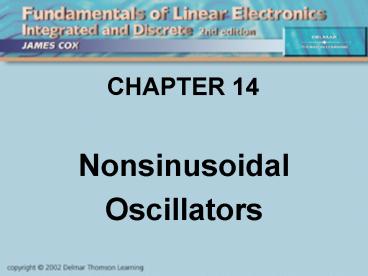Nonsinusoidal - PowerPoint PPT Presentation
1 / 19
Title:
Nonsinusoidal
Description:
There are other ways to make an oscillator besides phase-shifters ... If a potentiometer is used to adjust an RC time constant, check if it has been 'tweaked' ... – PowerPoint PPT presentation
Number of Views:209
Avg rating:3.0/5.0
Title: Nonsinusoidal
1
CHAPTER 14
- Nonsinusoidal
- Oscillators
2
Objectives
- Describe and Analyze
- Operation of the 555 IC
- Inverter oscillators
- Schmitt oscillators
- Wave-shaping
- Sawtooth oscillators
- Troubleshooting
3
Introduction
- There are other ways to make an oscillator
besides phase-shifters and resonators. - The term astable covers a group of oscillator
circuits, many based on hysteresis in one form or
another. It also covers chips designed for the
purpose, such as the 555. - The old term multivibrator is also used to name
these circuits. It goes back to vacuum tube days
when they actually used electromechanical
vibrators in circuits.
4
Square-Wave Oscillators
- Square wave from a free-running 555 circuit.
5
The Internals of a 555
- Frequency set by RA, RB, and C.
6
Functions of the 555
- The 555 is still popular after all these years
because it is easy to use. It performs two
functions - Square-wave oscillator (astable)
- One-shot (monostable)
- Strictly speaking, a square-wave has a 50 duty
cycle. But unless the duty cycle is low, astables
are called square-wave oscillators even if its
not 50. - A one-shot produces a fixed-width output pulse
every time it is triggered by a rising or
falling edge at its input.
7
555 Oscillator
- fOSC 1.44 / (RA 2RB) ? C
8
555 One-Shot
- ?t 1.1RC
9
Inverter Oscillator
- fOSC depends on the number of inverters (must be
odd).
10
A Calculation
- For the circuit of the previous slide, find the
frequency range if each inverter has a delay of
10 ns ? 1 ns. - Period T delay ? 2 ? of inverters,
- so TLONG 11 ns ? 2 ? 3 66 ns
- and TSHORT 9 ns ? 2 ? 3 54 ns
- So fLO 1 / 66 ns ? 15.2 MHz
- and fHI 1 / 54 ns ? 18.5 MHz
11
Crystal-Controlled
- ltinsert figure 14-15 heregt
- Commonly used for microprocessor clock.
12
Hysteresis Oscillator
- Schmitt trigger circuit on an op-amp.
13
Example Calculation
- For the circuit of the previous slide
- Let R1 R2 R3 10 k?. Let C1 .01 µF
- Find the frequency of oscillation.
- Hint it takes about 1.1 time constants to get
67 voltage on capacitor. - The 21 divider formed by R2 R3 keeps the ()
input at ?Vout / 2. C1 has to charge up to
Vout / 2 to flip the compara-tor. But it starts
from Vout / 2, which is equivalent to charging
from 0 to 2V / 3 with V applied. So, 1.1R1C1
110 µs, but it takes two flips for one cycle.
So f 1 / 220 µs ? 4.5 kHz.
14
Square to Triangle
- Integrating a square wave makes a triangle wave.
15
Triangle to Sine
- With enough diodes, the signal is very close to a
sine.
16
Sawtooth Oscillator
- Also called a ramp generator, it can be used to
generate the horizontal sweep in a CRT circuit.
17
A Relaxation Oscillator
- Shockley diode converts integrator into a
relaxation oscillator, so called because the
diode periodically relieves the capacitors
tension (voltage)
18
Sample Calculation
- For the circuit of the previous slide, let the
input resistor Ri 100 k, the feedback capacitor
C 0.1 ?F, and let Vin 1 Volt.
Calculate the frequency if the Shockley diode
fires at 10 Volts. - Iin 1V / 100 k 10 ?A, and charging a
capacitor with a constant current means the
voltage ramps up linearly at a rate of ?V / ?t
I / C. So ?t (C / I) ?V. - The period T (0.1 ?F / 10 ?A) ? 10 Volts 0.1
sec. - So f 1 / T 10 Hertz.
19
Troubleshooting
- As always, check all DC voltages.
- Typically, these oscillators either work or they
do not they do not tend to drift. - Frequencies are not precise (except for crystal
stabilized) so oscilloscope measurements are OK. - Though not often used, if an aluminum
electrolytic is the timing capacitor, it is a
suspect. - If a potentiometer is used to adjust an RC time
constant, check if it has been tweaked. - Look for physical damage to components.





























